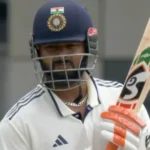The air smelled like…anticipation. And a little bit of humidity, honestly. I’ve spent a *lot* of my life breathing the air around football stadiums, and this one, the Kai Tak Stadium in Kowloon, had a distinct energy. I wasn’t there as a player or a coach this time, though. This trip was all about scouting, observing, and really *feeling* the pulse of Asian football as the AFC Asian Cup Qualifiers Final Round kicked off. Specifically, I was fixated on the match between India and Hong Kong, China.
For those who don’t know me, I’ve been involved in football – pretty much every side of it – for over twenty years. Started as a kitman, genuinely, learned the game from the ground up. Moved into youth scouting, then progressed to analyzing senior teams for both club and national associations. I’ve worked with everything from emerging leagues to Championship sides in England, always focusing on what makes players and teams *tick*. I’ve built a reputation, quietly, for spotting potential and understanding tactical shifts. I’ve seen what wins games, and, just as importantly, what loses them. This isn’t about bragging; it’s about building a foundation for why what I’m about to share has some weight behind it. I’m not just rattling off opinions; I’m pulling from decades of pattern recognition.
And this game, India versus Hong Kong, felt like a turning point for both nations.
**A Familiar Story: India’s Journey and the Pressure to Perform**
Let’s talk about India first. They’ve been knocking on the door of consistent success in the Asian Cup for a while now. You see flashes of brilliance, individual skill that’s genuinely exciting, but it’s often inconsistent. There are a few reasons for that, factors woven into the structure of Indian football itself.
Historically, Indian football has faced challenges with infrastructure. Developing quality pitches, nationwide academies, and a consistent youth development system that feeds into the senior team has been an ongoing process. We’re seeing progress, absolutely, with the All India Football Federation (AIFF) pushing for improvements, but it’s a long game. Compared to nations like Japan or South Korea, who invested heavily in youth systems decades ago, India is playing catch-up.
Another layer is the league itself, the Indian Super League (ISL). It’s raised the profile of the game enormously, brought in foreign talent, and increased professionalism. That’s great. But it’s also created a reliance on that foreign talent, sometimes at the expense of nurturing homegrown players to their full potential. You see some incredible Indian players emerge – Sunil Chhetri, of course, a legend – but the depth below that isn’t always where it needs to be. Finding the next generation, providing them with the right coaching, and giving them consistent game time are all key.
Because of this, the pressure on the national team is immense. Every qualifier feels vital, every win is celebrated like a major trophy, and every loss is scrutinized intensely. I could feel that weight on the players during the warm-up. They weren’t nervous in a panicked way, more…focused. A quiet intensity. They knew what this game meant.
From a tactical perspective, under Igor Stimac, India has been steadily evolving. He’s tried to instill a more proactive, possession-based style, but it’s a gradual shift. They’re good on the counter, very dangerous when they can spring forward quickly, but maintaining possession against more technically gifted opponents has been a recurring issue. And that’s where Hong Kong, China, were looking to exploit them.
**Hong Kong, China: A Tightly Wound Machine with a Point to Prove**
Hong Kong, China, are a different beast altogether. They aren’t a team brimming with individual superstars, but they are incredibly well-organized, disciplined, and tactically flexible. Their coach, Jorn Andersen, has sculpted a team that’s greater than the sum of its parts.
What struck me most about Hong Kong, China, was their work rate. They ran *relentlessly*. They pressed high, they tracked back, they closed down space. This isn’t a team that gives you an inch. They’re incredibly difficult to break down, and they’re always looking to punish you on the counter.
Their strength lies in their compactness. They defend in a tight block, denying space between the lines, forcing opponents to play wide, and then swarming anyone who tries to dribble into dangerous areas. This requires exceptional fitness, communication, and a collective understanding of their roles. Honestly, it’s a masterclass in how to maximize limited resources.
Historically, Hong Kong, China, have often been underestimated in Asian football. They lack the historical pedigree of some of the giants, and they don’t have the same level of investment. But they consistently overperform, punching above their weight. This is down to a strong football culture, a dedicated coaching staff, and a group of players who are fiercely proud to represent their nation. They are very adept at making games difficult, frustrating opponents, and capitalizing on any mistakes.
Before the match, I had a conversation with a colleague who scouts extensively in East Asia. He told me, “Don’t expect Hong Kong to try and outplay India. They’ll try and *outwork* them. They’ll suffocate them and force them into errors.” He was spot on.
**First Half: Tactical Battles and Opportunities Missed**
The first half unfolded exactly as predicted. Hong Kong, China, came out firing, pressing India high up the pitch, forcing them into long balls and rushed clearances. India struggled to build from the back, and their passing was often inaccurate under pressure.
I was observing Sunil Chhetri closely. At 39, he’s still the focal point of the Indian attack, but he’s no longer the dynamic, explosive player he once was. His movement is still intelligent, his finishing remains clinical, but he needs more support, more service. He was often isolated, battling two or three defenders at a time. India needed to get the ball to him in more dangerous positions, but they couldn’t retain possession long enough to do so.
Hong Kong, China, weren’t creating a ton of clear-cut chances, but they were constantly probing, looking for weaknesses in the Indian defense. Their captain, Huang Yang, was particularly impressive, shielding the back four, winning tackles, and starting attacks. He’s a real engine, a driving force in midfield.
What I also noticed was India’s reliance on crosses. They got the ball wide to Udanta Singh and Manvir Singh frequently, but Hong Kong, China, dealt with those crosses comfortably. Their center-backs, Lam Ka Wai and Chan Siu Kwan, were dominant in the air, winning almost every aerial duel. India needed to vary their attack, to find ways to play through the middle, but Hong Kong, China, weren’t giving them any space.
There were a couple of half-chances for India, a shot from Chhetri that was well saved by Yapp Hung Fai, and a header from Sandesh Jhingan that went just wide, but overall, Hong Kong, China, were the better team.
Between halves, I scribbled in my notebook: “India need to be braver in possession. They’re playing with fear. Hong Kong are winning the midfield battle. Stimac needs to address the lack of support for Chhetri.”
**Second Half: Penalty Drama and Shifting Momentum**
The second half started with more of the same. Hong Kong, China, continued to dominate possession, controlling the tempo of the game. India were struggling to cope with the relentless pressure, and they were increasingly resorting to long balls.
Then, around the 65th minute, the game changed. A clumsy challenge in the box by a Hong Kong defender on an Indian forward led to a penalty. It was a soft penalty, to be honest, but the referee didn’t hesitate.
Chhetri stepped up to take the penalty. The stadium held its breath. He slotted it home with his trademark composure. 1-0 to India.
It was a huge moment, a massive relief for the Indian players and fans. But it also changed the complexion of the game. Hong Kong, China, were forced to come forward, to take more risks. The game became more open, more stretched.
And that’s where India had a chance to capitalize. They started to find more space in midfield, to play more incisive passes. Anirudh Thapa, who had come on as a substitute, was starting to influence the game, dictating the tempo, and creating chances.
However, Hong Kong, China, weren’t going to roll over. They responded with wave after wave of attacks, testing the Indian defense. Their left-back, Wong Wai, was a constant threat, overlapping on the flank, delivering dangerous crosses.
Then, in the 90th minute, disaster struck for India. A handball by a defender inside the box led to a penalty for Hong Kong, China. It was a clear penalty, a stonewall decision.
The tension was unbearable. The entire stadium was on its feet. Chan Siu Kwan stepped up to take the penalty. He calmly slotted it past Gurpreet Singh Sandhu. 1-1.
The equalizer felt like a sucker punch for India. They had been ahead for so long, and now, in the dying moments of the game, they had let it slip.
**Stoppage Time: Heartbreak and a Lesson in Resilience**
The remaining minutes of stoppage time were frantic. Both teams were throwing everything at it, desperate to snatch a winner. India pushed forward, but they were leaving themselves exposed at the back. Hong Kong, China, had a couple of dangerous counter-attacks, but Gurpreet Singh Sandhu made a couple of crucial saves to keep the score level.
The final whistle blew. 1-1. A draw.
It was a heartbreaking result for India. They had been so close to victory, but they had failed to close the game out. However, it wasn’t a complete disaster. They had earned a valuable point on the road, and they were still in a good position to qualify for the Asian Cup.
But for me, watching from the stands, the draw brought into sharp focus some recurring themes in Indian football. The lack of composure under pressure, the inability to kill off games, the reliance on individual brilliance rather than collective strength. These are issues that need to be addressed if India wants to consistently compete at the highest level.
Hong Kong, China, on the other hand, deserved a lot of credit. They had shown incredible resilience, fighting back from a goal down to earn a draw. They had demonstrated their tactical prowess, their work rate, and their unwavering belief.
Throughout the whole match, one thing was clear: this wasn’t just about skill; it was about will. Hong Kong, China, embodied that, showing a determination that nearly snatched a win.
**Beyond the Scoreline: Analyzing the Wider Picture**
This game wasn’t just about India and Hong Kong, China. It was part of a larger narrative, a story of ambition and competition within Asian football. Group C includes Singapore and Bangladesh, and the fight for qualification is going to be fiercely contested. The dynamics between these teams are fascinating.
Singapore, under new coach Tsutomu Ogawa, are attempting to rebuild after a period of stagnation. They have some talented young players, but they lack experience and consistency. The match I witnessed them play against Bangladesh, led by Stefan Pereira, showed flashes of promise, but also exposed their defensive vulnerabilities. Pereira, a dynamic midfielder, orchestrated much of Bangladesh’s attacking play. His ability to find space and create opportunities was impressive and a real challenge for Singapore.
Bangladesh, while being the lowest-ranked team in the group, are a team with a growing sense of pride. They’re putting in the work, and Pereira has injected some much-needed energy into their midfield. But they need to improve their finishing if they want to have any chance of qualifying.
Looking at Saudi Arabia’s broader qualifying picture, it’s clear they are setting the standard. Their investment in infrastructure and youth development is paying dividends, and they consistently produce players who can compete at the highest level. The other teams in the region are looking to emulate their success, but it’s a long and arduous process.
What I found interesting was the increasing tactical sophistication across all the teams. Gone are the days of simply relying on physical prowess. Coaches are now meticulously analyzing opponents, devising intricate game plans, and adapting their tactics based on the situation. The game is becoming more cerebral, more strategic.
**What This Means for the Future**
The AFC Asian Cup Qualifiers Final Round is more than just a competition to determine who goes to the tournament. It’s a crucible, a testing ground for the future of Asian football. It’s where nations showcase their progress, identify their weaknesses, and lay the foundation for future success.
For India, the draw against Hong Kong, China, is a wake-up call. They need to address their shortcomings, improve their consistency, and develop a stronger team spirit. Stimac has a big job on his hands, but he has the potential to unlock India’s full potential.
For Hong Kong, China, it’s a testament to their hard work, dedication, and tactical intelligence. They’ve proven that they can compete with the best, and they’ll be a tough opponent for anyone.
I’ll be continuing to watch these teams closely, analyzing their performances, and tracking their progress. The journey to the Asian Cup is far from over, and I’m excited to see what the future holds.
Asian football is evolving rapidly, and it’s a privilege to witness it firsthand. This match, India versus Hong Kong, China, was just one small piece of the puzzle, but it offered valuable insights into the challenges and opportunities that lie ahead. It cemented something I’ve always believed, not just as a scout but as a lifelong fan: this isn’t just a game; it’s a story of ambition, resilience, and the relentless pursuit of excellence. And I, for one, can’t wait to see the next chapter unfold. The smells, the sounds, the weight of expectation… it’s why I keep coming back. It’s in the details and the subtle shifts that the real story of the game is told. It is what keeps me going.
Anurag Dhole is a seasoned journalist and content writer with a passion for delivering timely, accurate, and engaging stories. With over 8 years of experience in digital media, she covers a wide range of topics—from breaking news and politics to business insights and cultural trends. Jane's writing style blends clarity with depth, aiming to inform and inspire readers in a fast-paced media landscape. When she’s not chasing stories, she’s likely reading investigative features or exploring local cafés for her next writing spot.






